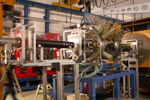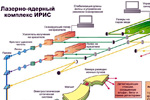|
STRUCTURE
ACTIVITIES
ACHIEVEMENTS
PUBLICATIONS
EVENTS
HISTORY
USEFUL INFORMATION
SOCIAL LIFE
|
|
 |
|
M a i n H E P D a ch i e v e m e n t s
BOOKLET "High Energy Physics Division PNPI. Main scientific activities."
BOOKLET "The proton synchrocyclotron SC-1000 turned 50 years old."
PNPI Reports:
PNPI 2007-2012 (28 Mb)
PNPI 2010-2013(5,6 Mb),
PNPI 2014(9 Mb),
PNPI 2015(6,7 Mb),
PNPI 2013-2018 (45 Mb),
PNPI HEPD 2018-2022

(continuation - page3)
|
Investigation of spatial distributions of the nuclear matter in exotic neutron-rich nuclei.
 Heads of the PNPI group: G.D. Alkhazov, A.V. Khanzadeev
Heads of the PNPI group: G.D. Alkhazov, A.V. Khanzadeev
A new method was proposed at PNPI for investigation of spatial nuclear structure of exotic nuclei by elastic scattering of the studied nuclei on protons at an energy of ~1 GeV/nucleon using an active hydrogen target (ionization spectrometer IKAR) developed at PNPI. The investigations were carried out at the Nuclear Centre of Heavy Nuclei
GSI
(Darmstadt, Germany). The following nuclei were investigated: :
6He, 8He, 8Li, 9Li, 11Li, 8B, 7Be, 9Be,
10Be, 11Be, 12Be, 14Be, 13C, 14C, 15C, 17C.
As a result, unique information on the distributions of the nuclear matter, on the sizes of the nuclear core and halo in the investigated nuclei has been obtained.
Production and investigation of short-lived nuclei.
 Heads of the PNPI groups: V.N. Panteleev (IRIS, IRINA), A.E. Barzakh (ISOLDE)
Heads of the PNPI groups: V.N. Panteleev (IRIS, IRINA), A.E. Barzakh (ISOLDE)
A unique nuclear-laser complex ULISS has been built at the PNPI synchrocyclotron.
This complex is used for production and investigation of exotic nuclei near the boarders of nuclear stability by the method of
resonant ionization spectrometry in a laser ion source. This method was proposed and realized for the first time at PNPI at
the mass-separator complex IRIS. With this method at PNPI and ISOLDE(CERN),
a number of experiments were performed with
the aim to determine charge radii and electromagnetic moments in about 80 neutron-deficient nuclei:
192-211, 216-219Po, 178-207Tl, 197-211, 217At è 177-182, 185,191Au.
The obtained results are important for theory of nuclear structure.
In experiments performed at ISOLDE (CERN), a new nuclear process has been discovered: asymmetric delayed fission of the nucleus 180Tl.
The delayed asymmetric fission of nuclei with such a small ratio N/Z as
N/Z = 1.25 has been established reliably for the first time.
The observed asymmetric nuclear fission is in contradiction with the data on low-energy fission of nuclei lighter than Ac.
The observation of this new fission mode demands a dedicated theoretical interpretation.
Hyperfine-structure parameters and isotope shifts for the 795-nm atomic transitions in 217,218,219At have been measured at CERN-ISOLDE, using the in-source
resonance-ionization spectroscopy technique. Magnetic dipole and electric quadrupole moments, and changes in the nuclear mean-square charge radii
 have been deduced. New data for At isotopes indicate the possible octupole deformation in 217-219At. This conclusion is supported by the analysis of magnetic
dipole moments of 217-219At measured in our experiment. Earlier the 85At isotopes were expected to lie outside the region of the quadrupole-octupole collectivity,
where inverse OES was previously established. Investigation of the octupole deformed nuclei is the one of topical direction of contemporary nuclear physics.
These nuclei prove to be a good benchmark to search for Ò- and Ð-violation effects beyond Standard model. Laser-spectroscopic experiments at CERN are considered
to be among the most important investigations, and they will be carried on after modernization of the ISOLDE complex.
have been deduced. New data for At isotopes indicate the possible octupole deformation in 217-219At. This conclusion is supported by the analysis of magnetic
dipole moments of 217-219At measured in our experiment. Earlier the 85At isotopes were expected to lie outside the region of the quadrupole-octupole collectivity,
where inverse OES was previously established. Investigation of the octupole deformed nuclei is the one of topical direction of contemporary nuclear physics.
These nuclei prove to be a good benchmark to search for Ò- and Ð-violation effects beyond Standard model. Laser-spectroscopic experiments at CERN are considered
to be among the most important investigations, and they will be carried on after modernization of the ISOLDE complex.

At present, a similar mass-separator complex
IRINA
for investigations of the neutron-excess nuclei which will
be produced at the high-flux neutron reactor PIK is under design. This complex will provide a record-breaking high yield of neutron-rich nuclei.
The shape and spatial structure of these nuclei will be studied using a laser ion source.
Such investigations are important for theory of atomic nuclei and for astrophysics as well. Recently, the technical proposals for all main parts
of IRINA (target-ion source system, mass-separator with ion guides, laser installation and the special hot cell) have been prepared and discussed with
the possible manufactures.

|

|
 |
 |